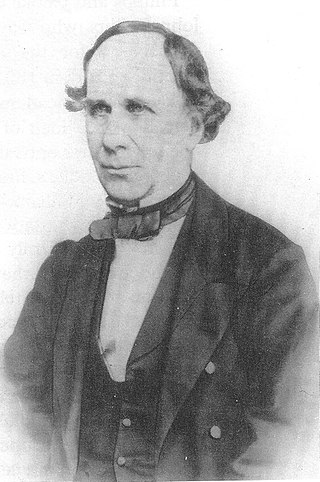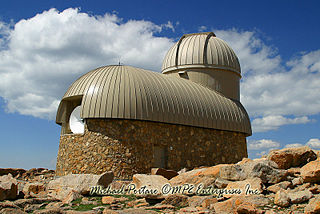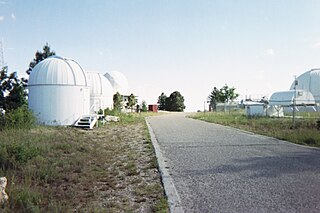Related Research Articles

The Lick Observatory is an astronomical observatory owned and operated by the University of California. It is on the summit of Mount Hamilton, in the Diablo Range just east of San Jose, California, United States. The observatory is managed by the University of California Observatories, with headquarters on the University of California, Santa Cruz campus, where its scientific staff moved in the mid-1960s. It is named after James Lick.

The Cerro Tololo Inter-American Observatory (CTIO) is an astronomical observatory located on the summit of Mt. Cerro Tololo in the Coquimbo Region of northern Chile, with additional facilities located on Mt. Cerro Pachón about 10 kilometres (6.2 mi) to the southeast. It is approximately 80 kilometres (50 mi) east of La Serena, where support facilities are located. The principal telescopes at CTIO are the 4 m Víctor M. Blanco Telescope, named after Puerto Rican astronomer Víctor Manuel Blanco, and the 4.1 m Southern Astrophysical Research Telescope, which is situated on Cerro Pachón. Other telescopes on Cerro Tololo include the 1.5 m, 1.3 m, 1.0 m, and 0.9 m telescopes operated by the SMARTS consortium. CTIO also hosts other research projects, such as PROMPT, WHAM, and LCOGTN, providing a platform for access to the southern hemisphere for U.S. and worldwide scientific research.

Leiden Observatory is an astronomical institute of Leiden University, in the Netherlands. Established in 1633 to house the quadrant of Willebrord Snellius, it is the oldest operating university observatory in the world, with the only older still existing observatory being the Vatican Observatory.

Thomas Cooke was a British scientific instrument maker based in York. He founded T. Cooke & Sons, the scientific instrument company.

The Hale Telescope is a 200-inch (5.1 m), f/3.3 reflecting telescope at the Palomar Observatory in San Diego County, California, US, named after astronomer George Ellery Hale. With funding from the Rockefeller Foundation in 1928, he orchestrated the planning, design, and construction of the observatory, but with the project ending up taking 20 years he did not live to see its commissioning. The Hale was groundbreaking for its time, with double the diameter of the second-largest telescope, and pioneered many new technologies in telescope mount design and in the design and fabrication of its large aluminum coated "honeycomb" low thermal expansion Pyrex mirror. It was completed in 1949 and is still in active use.

Armagh Observatory is an astronomical research institute in Armagh, Northern Ireland. Around 25 astronomers are based at the observatory, studying stellar astrophysics, the Sun, Solar System astronomy and Earth's climate.

The Institute of Astronomy (IoA) is the largest of the three astronomy departments in the University of Cambridge, and one of the largest astronomy sites in the United Kingdom. Around 180 academics, postdocs, visitors and assistant staff work at the department.

The Haleakalā Observatory, also known as the Haleakalā High Altitude Observatory Site, is Hawaii's first astronomical research observatory. It is located on the island of Maui and is owned by the Institute for Astronomy of the University of Hawaiʻi, which operates some of the facilities on the site and leases portions to other organizations. Tenants include the Air Force Research Laboratory (AFRL) and the Las Cumbres Observatory Global Telescope Network (LCOGTN). At over 3,050 meters (10,010 ft) in elevation, the summit of Haleakalā is above one third of the Earth's troposphere and has excellent astronomical seeing conditions.

Meyer–Womble Observatory (MWO) is an astronomical observatory owned and operated by the University of Denver. It is located near the summit of Mount Blue Sky in the Arapaho National Forest approximately 60 kilometers (37 mi) west of Denver, Colorado (USA). At an elevation of 4,326 meters (14,193 ft), it is the third-highest optical/infrared observatory in the world, and was the highest until the Indian Astronomical Observatory opened in 2001.

The Leander McCormick Observatory is one of the astronomical observatories operated by the Department of Astronomy of the University of Virginia, and is situated just outside Charlottesville, Virginia (US) in Albemarle County on the summit of Mount Jefferson. It is named for Leander J. McCormick (1819–1900), who provided the funds for the telescope and observatory.

Mount Laguna Observatory (MLO) is an astronomical observatory owned and operated by San Diego State University (SDSU). MLO is located approximately 75 kilometers (47 mi) east of downtown San Diego, California, on the eastern edge of the Cleveland National Forest, in the Laguna Mountains on the SDSU Astronomy Campus near the hamlet of Mount Laguna.
Anderson Mesa Station is an astronomical observatory established in 1959 as a dark-sky observing site for Lowell Observatory. It is located at Anderson Mesa in Coconino County, Arizona, about 12 miles (19 km) southeast of Lowell's main campus on Mars Hill in Flagstaff, Arizona.

Mount Lemmon Observatory (MLO), also known as the Mount Lemmon Infrared Observatory, is an astronomical observatory located on Mount Lemmon in the Santa Catalina Mountains approximately 28 kilometers northeast of Tucson, Arizona (US). The site in the Coronado National Forest is used with special permission from the U.S. Forest Service by the University of Arizona's Steward Observatory, and contains a number of independently managed telescopes.

The University of Illinois Astronomical Observatory, located at 901 S. Mathews Avenue in Urbana, Illinois, on the campus of the University of Illinois Urbana–Champaign, was built in 1896, and was designed by Charles A. Gunn. It was listed on the National Register of Historic Places on November 6, 1986, and on December 20, 1989, was designated a National Historic Landmark.

Airdrie Observatory is a fully operational, historic astronomical observatory, which is part of the library building in the town of Airdrie, North Lanarkshire, Scotland. There are only four public observatories operating in the United Kingdom, all of which are in Scotland. Airdrie Observatory is the smallest, and second oldest.

Fuertes Observatory is an astronomical observatory located on the North Campus of Cornell University in Ithaca, New York. The observatory was designed by L.P. Burnham, Cornell Professor of Architecture and completed in fall of 1917. It was originally used by the Civil Engineering Department as an instructional field office for navigation and surveying. Today, the observatory is primarily used for public outreach, welcoming over two thousand visitors per year with open houses on clear Friday nights.

The Dearborn Observatory is an astronomical observatory located on the Evanston campus of Northwestern University. The observatory was originally constructed in 1888, through an agreement between the university and the Chicago Astronomical Society. In the summer of 1939, Dearborn Observatory had to be moved to make way for the construction of the Technological Institute.

The Zagreb Astronomical Observatory is the astronomical observatory located in Zagreb, the Croatian capital, and founded in 1903. It is managed by the Zagreb Astronomical Society; its main purpose is educational.

The Toronto Magnetic and Meteorological Observatory is a historical observatory located on the grounds of the University of Toronto, in Toronto, Ontario, Canada. The original building was constructed in 1840 as part of a worldwide research project run by Edward Sabine to determine the cause of fluctuations in magnetic declination. Measurements from the Toronto site demonstrated that sunspots were responsible for this effect on Earth's magnetic field. When this project concluded in 1853, the observatory was greatly expanded by the Canadian government and served as the country's primary meteorological station and official timekeeper for over fifty years. The observatory is considered the birthplace of Canadian astronomy.

The Royal Observatory, Cape of Good Hope, is a former scientific institution in South Africa. Founded by the British Board of Longitude in 1820, its main building is now the headquarters building of the South African Astronomical Observatory.
References
- ↑ Jayaratne, Chandana. "The Forerunner of Modern Astronomy in Sri Lanka". Mathematical and Astronomical Society, University of Colombo. Archived from the original on 22 July 2011. Retrieved 16 June 2011.
6°54′05″N79°51′41″E / 6.90143°N 79.86139°E